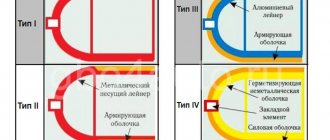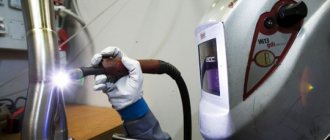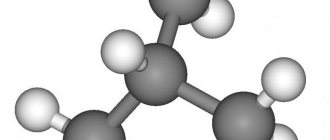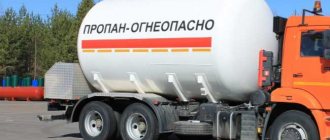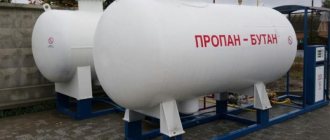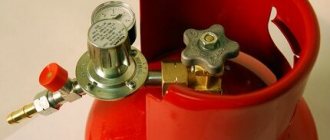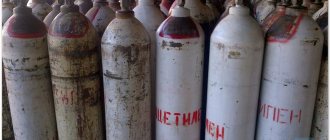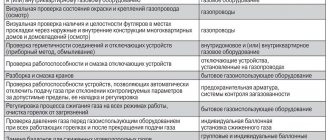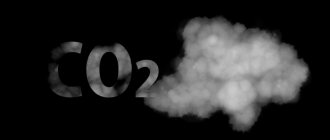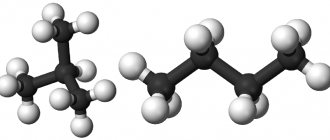Have you ever tried to detect a gas leak in the kitchen by smell? What if there is no smell or it is difficult to detect? Agree that those who understand the main differences between gas mixtures and know how to identify them feel more confident. It is important to know what liquefied gas is in cylinders and how it will behave if the integrity of the gas pipeline is violated. This is a security issue.
Each type of fuel has its own characteristics. Specific heat of combustion, color, smell, spontaneous combustion temperature - all these are signs by which we identify a substance. An important parameter is molar mass. The distribution of gas during a leak depends on this value: it will accumulate below, filling the basement, or, conversely, it will rise.
The ability to understand balloon mixtures is the key to proper operation and the absence of fatal errors during replacement and disposal. In addition, knowledge of the theory will help you make an informed choice when purchasing. And this is already half the battle.
Natural or liquefied - what's the difference?
When choosing a fuel source, the user may come across two concepts: natural gas and liquefied gas. The first, in most cases, is transmitted through urban backbone networks. Much less often it can be purchased in a compressed state in containers. The second is the traditional composition for propane and butane cylinders.
Characteristics of natural gas
The main component is methane . It accounts for almost no less than 70%.
The remaining parts are distributed among heavy hydrocarbons:
- propane;
- butane;
- ethane;
- pentane.
In addition, the composition includes hydrogen, nitrogen, carbon dioxide and a small amount of hydrogen sulfide. It is important to know that natural gas is odorless and colorless. Therefore, it is customary to enrich natural gas in cylinders with odorants - substances with a pungent odor.
You don't have to sniff to detect a leak. Due to its volatility, the compound instantly spreads indoors and quickly attracts attention.
If you feel an unpleasant odor, the first thing you need to do is open the windows in the room where the cylinder is located. Then go out and call the gas service. It is prohibited to check the concentration of the mixture in the air using a match or lighter.
The most common odorant is ethanethiol, which smells like rotten or rotten eggs. In large quantities this compound is toxic. In low concentrations, characteristic of the classic composition of a household gas mixture, it is absolutely harmless.
Advantages of liquefied gas
The liquefied gas is propane and butane, mixed in different proportions. Under high pressure, these carbons turn into liquid and noticeably decrease in volume. The reverse process is possible with increasing temperature - heating entails expansion of the substance. Therefore, cylinders for liquefied hydrocarbon gases are manufactured strictly in accordance with GOST standards and are filled no more than 85%.
The undeniable advantage of propane-butane gas is its lightness. A cylinder filled with such a mixture will be several times lighter than a similar container with methane.
Other advantages:
- environmental Safety;
- a strong specific odor is a useful indicator of leakage;
- low cost.
A properly configured stove connected to a cylinder with hydrocarbon gas will operate without soot and produce even streams of burning fuel.
Precautions for safe use
When liquefied propane comes into contact with air, it can form an explosive mixture. The maximum permissible value is considered to be the propane content in the air of the working area, not exceeding 300 mg/m³. It is unacceptable to have flame sources in rooms where there is even a slight odor of gas. Propane is heavier than air, and therefore it can settle and accumulate in areas with poor ventilation. Gas contact with an open area of skin is excluded - exposure to liquefied hydrocarbons causes frostbite, leading to tissue damage.
When working with propane, personal respiratory protection measures should be observed - inhaling propane has an intoxicating effect on the human body (dizziness, intoxication, loss of consciousness). Gas tends to accumulate in the body and is quickly eliminated, without accumulation in the internal organs.
Previous articleWhat you need to know about acetylene?
Next articleComposition and characteristics of welding mixtures
Winter and summer mixtures
Since only one 5-liter cylinder is allowed in residential premises, larger containers are installed outside the home. Accordingly, the climatic conditions during use can be anything. Taking this factor into account, gas compositions are created for the warm and cold seasons, which are described in more detail here.
What is the difference between the seasonal versions?
Inside the cylinder, liquefied gas is in two states of aggregation: liquid and gaseous. The intensity of filling the gas duct with the gaseous fraction directly depends on the temperature: in warm conditions the indicator is higher than at low temperatures.
The graph shows that mixing propane and butane allows you to balance the ability of these compounds to evaporate. This is the basis of the principle of creating “climate” compositions
Correction of this situation is carried out by changing the proportions of propane and butane. The first is capable of evaporating at 42 degrees below zero. The second loses this ability immediately after crossing the zero mark.
Therefore, in winter versions, the volume of propane increases. In summer, on the contrary, it decreases. This approach makes it possible to reduce the cost of summer versions due to cheaper butane and ensure the efficiency of winter ones.
Calculation of proportions taking into account climate
When determining the recommended proportions, the central part of Russia was taken as the starting point. The minimum propane content for the winter version is limited to 70%. In the summer version, 50 percent content is acceptable.
The abbreviation SPBT means a mixture of propane and technical butane - the proportions are selected according to needs. BT – technical butane contains 60% butane. PT – technical propane – minimum 75% propane
The composition for other regions is carried out taking into account the distance from the middle zone and climatic conditions. This must be done by specialists from licensed organizations.
Universal option for any temperature
Correct functioning of portable gas systems over a wide temperature range is typical for the combination of propane, isobutane and butane. Having different combustion temperatures, these substances made the complex composition as versatile as possible.
Application
Due to its properties, such as high calorific value during combustion, combustion without residue, harmlessness and safety when used correctly, ease of use, propane is a universal gas and is widely used both in production and in everyday life.
For industrial and domestic purposes it is supplied in the form of a technical propane-butane mixture. Butane (C4h20) is an organic compound of the alkanes class. Today, the demand for SPBT is huge. In production When performing gas-flame work in factories and enterprises: – in procurement production; – for cutting scrap metal; – for welding non-critical metal structures. During roofing work. For heating industrial premises in construction. For heating industrial premises (on farms, poultry farms, in greenhouses). For gas stoves, water heaters in the food industry. In everyday life - when preparing food at home and on the go; – for heating water; – for seasonal heating of remote premises – private houses, hotels, farms; – for welding pipes, greenhouses, garages and other utility structures using gas welding stations.
Recently, it has been widely used as automobile fuel, because... cheaper and more environmentally friendly than gasoline. In the chemical industry it is used to obtain monomers for the production of polypropylene. It is the starting material for the production of solvents. In the food industry, propane is registered as a food additive E944 as a propellant.
Refrigerant. A mixture of dried pure propane (R-290a) (a commercial designation to describe isobutane-propane mixtures) with isobutane (R-600a) is non-ozone depleting and has a low Greenhouse Potential (GWP). The mixture is suitable for functional replacement of obsolete refrigerants (R-12, R-22, R-134a) in traditional stationary refrigeration and air conditioning systems.
Quality indicators of liquefied hydrocarbon gases are determined according to GOST 10157-79.
Painting and marking of gas cylinders
Surprisingly, the world has not yet come to a unified system for marking gas cylinders. Therefore, when choosing a fuel source abroad, it is necessary to study local regulations. In Russia, all containers with gas mixtures used for cooking on the stove have a white transverse inscription on a plain red background.
Propane is never used to fill cylinders in its pure form. However, the inscription is made according to the predominant substance. This rule applies to other mixtures as well.
All other information is on a metal plate - a kind of product passport. This is the service life, serial number, empty container weight, date of manufacture and next certification, manufacturer’s trademark, test pressure.
Coloring and marking standards are the same for methane and propane-butane mixtures - only red cylinders with white lettering are suitable for use in the kitchen. Other colors may mean that the container is filled with nitrogen, argon, ammonia, helium, or freon.
Gas technical characteristics:
- the share of propane is at least 75% of the total volume;
- liquid residue does not exceed 0.7%;
- mercaptan sulfur and hydrogen sulfide do not exceed 0.013%;
- at a temperature of -20 °C, saturated propane steam creates a pressure of at least 0.16 MPa;
- the minimum possible combustion temperature is -35 °C;
- the flame temperature when burning pure propane increases to 2526 °C;
- specific heat of combustion 48 MJ/kg.
Also among the advantageous features of propane are its inertness, passivity to chemical influences, and resistance to oxidation. Technical propane has high calorific value, which is especially important when performing gas welding work. Propane cylinders are unpretentious in terms of transportation and storage, which makes its operation as convenient as possible.
How to detect a leak?
The difference between methane and propane-butane mixture leaks is the smell. But in both cases, the stench will make itself felt first.
To detect the penetration of both trains into the airspace, 4 methods are suitable:
- Definition by hand. Household gases are colder than air. By running your hand over the flange connections and joints of gas pipeline elements, you can easily feel the emanating chill.
- Using soap solution . Bubbles that appear on the treated surface indicate a problem.
- Installation of a stationary sensor . Models that provide not only a digital signal in the form of instrument readings, but also an audio signal are preferred.
- Measurement with a portable device.
The method for measuring the concentration of a harmful compound in the air using portable sensors depends on the composition of the gas in household cylinders installed in the kitchen or outside the home.
A red lamp indicates possible danger. The lighting of the green lamp is a confirmation of well-being. If in doubt, it is worth repeating measurements near possible leaks: at joints and connections
When measuring propane/butane leakage, the device must be installed at the lowest point in the room. The heavy mixture will primarily fill the space near the floor.
The situation with methane is the opposite - this gas is two times lighter than air. Therefore, as it evaporates, it will move upward. Accordingly, measurements will have to be taken from the ceiling.
Ethane C2H6
Ethane C2H6, like methane, is found in oil and in gases released from the ground in oil-bearing areas. It is also found in gases obtained by dry distillation of coal, and in gaseous products of cracking and pyrolysis of oil. In laboratories, ethane is usually obtained by reducing ethyl iodide with zinc dust in an alcohol solution.
or electrolysis of sodium acetate.
Ethane
- a colorless gas that burns with a faintly luminous flame. It can be condensed into liquid already at 4 ° C and a pressure of 46 at. It is almost insoluble in water; 1 volume of absolute alcohol dissolves 1.5 volumes of ethane. At 575-650° C in the absence of catalysts, ethane decomposes into ethylene and hydrogen:
How to calculate the fullness of a cylinder?
The filling of the cylinder with the mixture can be easily determined by its weight. To do this, you need to know the weight of the empty container and the weight of the gas. Both values are always indicated on the metal passport of the product. This could be a rectangular plate or a disc around the valve. The sum of these two values is equal to the mass of a fully filled cylinder. A decrease in the amount indicates fuel consumption.
The weight of the mixture of butane and propane depends on the selected proportion, since propane is a lighter gas. At zero temperature, one liter of a 1:1 mixture will weigh 564 grams. The weight of one liter of methane under the same conditions will be equal to 710 grams.
Prospects for liquefied hydrogen
In addition to direct liquefaction and use in this form, it is also possible to obtain another energy carrier from natural gas - hydrogen. Methane is CH4, propane is C3H8, and butane is C4H10.
The hydrogen component is present in all these fossil fuels, you just need to isolate it.
The main advantages of hydrogen are environmental friendliness and widespread occurrence in nature, however, the high price of its liquefaction and losses due to constant evaporation reduce these advantages to almost nothing
To transform hydrogen from a gas into a liquid, it must be cooled to -253 °C. For this purpose, multi-stage cooling systems and “compression/expansion” installations are used. Currently, such technologies are too expensive, but work is underway to reduce their cost.
We also recommend reading our other article, where we described in detail how to make a hydrogen generator for your home with your own hands. For more details, follow the link.
Also, unlike LPG and LNG, liquefied hydrogen is much more explosive. The slightest leak of it in combination with oxygen produces a gas-air mixture that ignites at the slightest spark. And storage of liquid hydrogen is possible only in special cryogenic containers. Hydrogen fuel still has too many disadvantages.
Reasons for the prevalence of propane mixtures
Compositions of propane and butane are much more often used as raw materials for filling household gas cylinders.
The reasons are simple:
- Propane is easier to liquefy. To influence it, a pressure of 16 atmospheres is enough. Methane will only become liquid after exposure to 150 atmospheres.
- Inexpensive cost of producing liquefied gas in comparison with a methane mixture.
- Less durable cylinders, which has a positive effect on the price.
- Safety of use.
Using a container with an internal pressure of 16 atmospheres is much safer. And this is an important selection criterion.
Natural gas as a vehicle fuel
Propane or methane – what to choose?
Most cars that switch to gas fuel use propane-butane. But what about methane, because auto manufacturers mass-produce cars using this fuel and consider it promising. So why is this happening?
Thirdly, natural gas reserves are huge, they will last for the next 150 years, and the price is 3 times cheaper than automobile fuel. But we must take into account that gas fuel consumption will be slightly higher, because You can travel as far with one cubic meter of methane as with 1.1 liters of gasoline.
What are the disadvantages of methane? The main reason is the poorly developed infrastructure of methane gas stations - there are only 250 of them in Russia. It turns out that methane is more environmentally friendly, cheaper, and safer than gasoline - and increases engine life: it does not leave carbon deposits in the combustion chamber and does not wash off the oil film from the cylinder walls. But there are almost no gas stations. Therefore, another type of gas is preferred among private owners - propane-butane.
Pros and cons of propane-butane
Despite the fact that gas consumption is approximately 10-15% more than gasoline, the savings are significant. All costs for the purchase and installation of gas equipment are paid off in 10-20 thousand kilometers, because The cost of propane-butane is one and a half times cheaper than gasoline. As a rule, there are no problems with refueling - the network of propane-butane gas stations is extensive throughout the country.
Gas equipment is actually an additional tank, increasing the range by 200-500 km. Operating such a car will not cause any trouble. The engine starts on gasoline and when the temperature reaches +25 o C in the cooling system it switches to gas fuel. The automation thereby ensures that the gas reducer does not ice up. In addition, the transition from one type of fuel to another can be done manually directly from the cabin.
If we compare driving in the city, there is no noticeable difference between driving on gas and gasoline. There will be no problems with starting and reactions to the gas pedal, but in extreme modes there is not enough power. Thus, running on gas reduces the output of a 106 hp production engine. up to 98 hp This can become inconvenient when overtaking on the highway, but the solution is to switch to petrol in advance.
The main disadvantage is a significant reduction in trunk volume. An additional tank is installed in the spare tire niche, and the spare wheel itself will have to be moved to the trunk. In hatchbacks, the gas cylinder generally ends up in the cabin. This negates the design advantages that make it possible to increase trunk volume by folding the rear seats.
Another disadvantage: gas is potentially more dangerous than gasoline. Of course, high-quality installed equipment does not cause trouble for the owner
However, its technical condition should be given close attention. Note that the gas is explosive only in a 5-10 percent ratio with air, and such a concentration cannot be created in the open air
And even more so in a moving car.
Less significant disadvantages of refueling a car with gas fuel include a slight deterioration in the acceleration dynamics of the car (by 5%), which, however, is compensated by a slight increase in gas consumption. In addition, the burning time of the gas is longer than that of gasoline, and the temperature in the combustion chamber is higher.
Disposal of gas cylinders
Compliance with the rules of safe disposal is mandatory for gas cylinders with any composition. They must be handed over to specialized collection/exchange points. Despite the fact that propane-butane gas is contained in a container at a lower pressure than methane gas, the possibility of an explosion remains. The reason for this is the high residual pressure of propane.
Some companies offer profitable exchanges of old containers for new ones or make significant discounts on the purchase of new cylinders when returning used containers
The main motives for opening old containers on your own are the use of empty containers for household purposes and scrap metal. Experts advise abandoning such ideas or using the help of professionals. The main thing is to remember that a solid cylinder is never completely free of the gas mixture.
An excellent solution is to hand over the cylinder to a private service company. As a rule, their prices significantly exceed the benefits of scrapping the container. An additional bonus is pickup, when representatives of the organization go to pick up the equipment at the specified address.
What to look for when buying
When buying a new cylinder in a store, check its passport, which indicates compliance with GOST and TU, information about the manufacturer, empty and full weight of the tank, certification. This information is duplicated on the tank body closer to the valve. The data is stamped on the cylinder itself or on an attached plate.
When receiving a used cylinder during an exchange, make sure that there are no dents on it. Be sure to check the date of the next technical inspection. If it is expired, ask for another cylinder.
Conclusions and useful video on the topic
In order not to make a mistake when choosing, you can focus on the color of the container. To connect to a gas stove, use red cylinders with white inscription:
The most popular composition used to fill household cylinders is a mixture of propane and butane. Correctly selected proportions allow you to effectively use the physical properties of both substances.
Please note that a cylinder with an inscription that does not meet the requirements must be removed from service. Any attempts to paint over or change the name are a violation of the rules.
Maybe you have useful experience using cylinders for a gas stove, are you well versed in the composition, or have you ever managed to notice a leak in time? Write about it in the comments. Your experience may be invaluable to other users.
How do alkanes differ from other chemical compounds?
“Paraffins” are chemical compounds that have low reactivity. Alkanes do not dissolve in water and do not have any color. When burned, alkanes emit a lot of heat, and their flame is colorless or light blue. This class of compounds is actively used in industry, in particular in the synthesis of fuel and oil.
In the table you can see a list of substances that belong to the class of alkanes.
